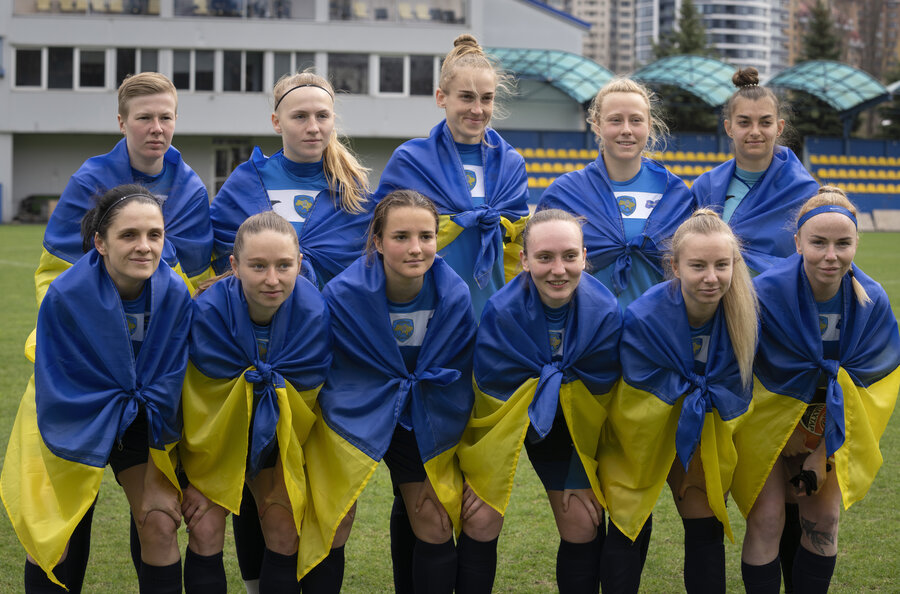Mariupol women’s soccer team kicks back against Russian occupation
Loading...
| Kyiv, Ukraine
In an empty stadium in Ukraine’s capital, a group of women soccer players draped in blue-and-yellow flags is getting ready for the match of the day.
As at every game these days, they observe a minute of silence for those who died because of Russia’s invasion of Ukraine.
The logo on their uniform reads: “Mariupol is Ukraine.”
They are members of the Mariupol Women’s Soccer Team. The eastern port city was devastated and captured by Russian forces last year after more than two months of stiff resistance by outmanned and outgunned Ukrainian forces, turning Mariupol into a worldwide symbol of Ukrainian defiance.
The city is now under Russian occupation, illegally annexed in September by the Russian president.
Refusing to give up, five original players from Mariupol have formed a new team based in Kyiv, recruiting members from all over the country.
Their goal? Not only to keep their place in the league but also to remind everyone that despite the Russian occupation that will soon reach the one-year mark, Mariupol remains a Ukrainian city.
“The main motivation was that people would watch the videos on social media from every game every week, and would see that the Mariupol team [still] exists,” said coach Karina Kulakovska.
This week, the team was playing a match for the Ukrainian championship against the “Shakhtar” team, a tiny snapshot of normality on a soccer pitch. But not quite.
The authorities have banned spectators from attending the match due to security risks, resulting in an empty stadium and an eerie silence. To reach the field, players use an entrance, which is stacked with sandbags, bearing the word “shelter.”
Midfielder Alina Kaidalovska remembers the 60 seconds of silence before the start of her first game in Kyiv after she fled Mariupol.
“Everything that happened in Mariupol immediately flashed through my head,” she said. As memories flooded her mind, she recalled the bombed and charred buildings in the besieged city, the terror of running and hiding from Russian strikes, and the heartbreak of seeing people lose their lives.
In a humble stadium nestled amidst Kyiv’s multistory buildings, she and the other players gather for two hours every morning for training. They know they won’t win this year’s Ukrainian championship but keep training so that the team stays afloat.
“That was a good one, Margo! Give it more power next time,” shouted Ms. Kulakovska. In 2015, she embarked on her coaching career and co-founded the Mariupol Women’s Soccer Team along with club president Yana Vynokurova. It is now the oldest women’s team in Ukraine’s Donetsk province, a region that has been largely devastated by the ongoing war.
In early 2022, the Mariupol team ranked fourth in the top league of women’s clubs. But the war Russia started in Ukraine on Feb. 24, 2022, not only interrupted the soccer season but thwarted the Mariupol team’s ambitions to rise higher in the rankings as it brought calamity to their city and scattered players all over the world.
The core members of the team, including the club president and the head coach, sought refuge in Bulgaria as they struggled to come to terms with the trauma of their time spent in besieged Mariupol.
But when a new soccer season began in August, the idea of returning to Ukraine and starting their team again gave them the hope and courage to take the risk, even though they had nothing. Other clubs and people donated equipment – even soccer shoes.
After a turbulent first few months, the club has now grown to 27 members, ranging in age from 16 to 34. Despite the diversity of their native cities, their dark blue training suits proudly display the logo linked to Mariupol, which features a seagull with a soccer ball in the background – a nod to the city’s location on the north shore of the Sea of Azov.
A myriad of problems and a lack of funding notwithstanding, the women are determined to play.
“The girls go out on the pitch, and they fight until the end. They have a crazy dedication, and a crazy desire to play,” said Ms. Vynokurova. The players have a higher mission to pursue, in addition to keeping the Mariupol club afloat.
“That is to leave Mariupol at least on the soccer map of Ukraine, so that we remember that the people of Mariupol are the same fighters as Azov, who defended our city to the end.”
Team captain Polina Polukhina hopes she will one day return to the stadium in Mariupol, her native city.
“Deep down, you hope that you will return there again,” she said. She has played soccer since she was 18 years old and said it was an honor for her to be part of the Mariupol team, even in such difficult times.
Ms. Vynokurova is confident that every time the Mariupol team shows up for a game, it sends a message: “Even if you’ve lost everything, you can’t give up.”
This story was reported by The Associated Press.





